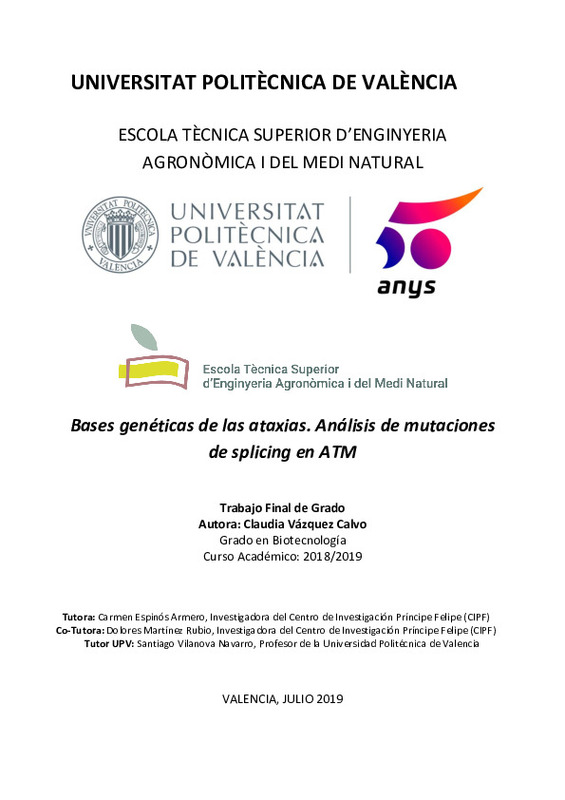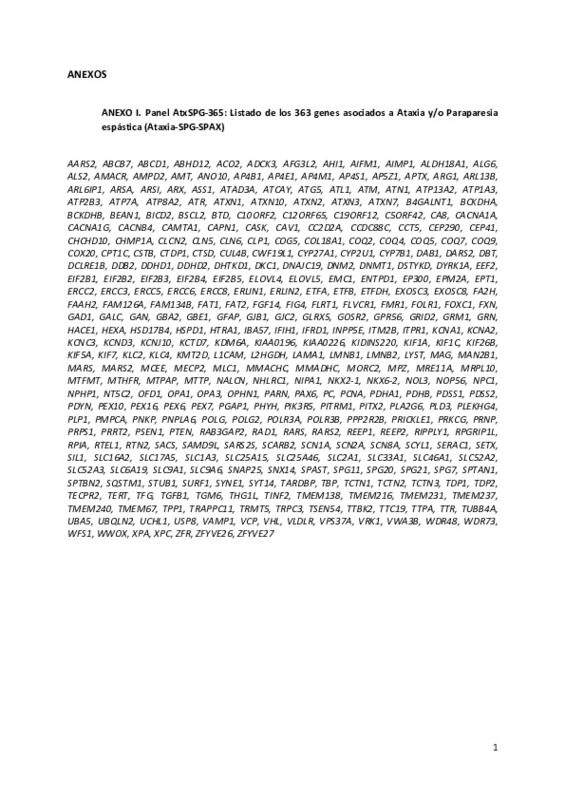|
Resumen:
|
[ES] Las ataxias cerebelosas son un grupo heterogéneo de enfermedades del sistema nervioso central de
carácter progresivo debidas a un proceso degenerativo que afecta a sistemas neuronales selectivos
del cerebelo y sus ...[+]
[ES] Las ataxias cerebelosas son un grupo heterogéneo de enfermedades del sistema nervioso central de
carácter progresivo debidas a un proceso degenerativo que afecta a sistemas neuronales selectivos
del cerebelo y sus vías. Los síntomas motores incluyen pérdida del equilibrio y de la coordinación,
marcha inestable, disartria y movimientos oculares anómalos. Las ataxias hereditarias se suelen
clasificar en dos grupos principales: ADCAs (Autosomal Dominant Cerebellar Ataxias) y ARCAs
(Autosomal Recessive Cerebellar Ataxias), si bien también existen las formas ligadas al X. La
prevalencia global de las ADCAs se estima en 1-5/100.000 y de las ARCAs en 3/100.000. Las ADCAs
más frecuentes son las SCAs (SpinoCerebellar Ataxias) y las formas ARCA más comunes son la ataxia
de Friedreich y las ataxias con mutaciones en el gen SPG7. Tanto para un grupo como para otro de
ataxias, se conocen más de 80 genes implicados y esta cifra sigue creciendo. La disponibilidad actual
de técnicas de secuenciación de última generación (NGS, Next Generation Sequencing) facilita
indudablemente la consecución de un diganóstico genético de una forma más rápida y eficaz.
Bases genéticas de las ataxias. En el marco de un proyecto de mecenazgo (http://indacea.org/)
hemos diseñado una nueva herramienta de diagnóstico molecular para ataxias y paraparesias
espásticas (SPGs). Hemos diseñado un panel con tecnología SureSelectXT (Agilent) para MiSeq
(Illumina), que comprende 363 genes asociados con estos grupos de trastornos (panel AtxSPG-365).
Así, en el marco del presente trabajo fin de grado se han investigado 19 pacientes con ataxias, cuyos
datos crudos se han filtrado de acuerdo con un pipeline de diseño propio para la priorización de
variantes de interés. Éstas han sido posteriormente analizadas mediante análisis de segregación con
el propósito de lograr evidencias que afiancen o descarten que realmente son mutaciones clínicas.
Análisis de una mutación de splicing en ATM. En una paciente de nuestra serie clínica de ataxia,
mediante el panel AtxSPG-365 se identificaron dos cambios intrónicos en el gen ATM
(NM_000051.3): c.2921+1G>A (rs587781558, intrón 19)/c.1899-11C>G (rs730881282, intrón 12).
ATM está implicado en la ataxia telangiectasia (AT; MIM 208900), una enfermedad rara pediátrica. La
AT cursa con herencia autosómica recesiva y clínicamente se caracteriza por ataxia cerebelar y otras
manifestaciones neurológicas, telangiectasias, y afectación del sistema inmune. El cuadro clínico de
la paciente era compatible con el definido para la AT y por ello, era nuestro interés indagar si
realmente estas mutaciones afectaban a la proteína resultante. Para ello se han llevado estudios
genéticos adicionales (análisis de segregación) e in silico, y analizando la expresión del ARNm de la
paciente, se ha investigado si la mutación afecta al procesado correcto de la proteína.
[-]
[EN] Cerebellar ataxias are a heterogeneous group of diseases of the central nervous system of
progressive character, due to a degenerative process that affects to selective neuronal systems of
the brain and its pathways. ...[+]
[EN] Cerebellar ataxias are a heterogeneous group of diseases of the central nervous system of
progressive character, due to a degenerative process that affects to selective neuronal systems of
the brain and its pathways. Motor symptoms include loss of balance and coordination, unsteady gait,
derangement, and abnormal eye movements. Hereditary ataxias are usually classified into two main
groups: ADCA (Autosomal Dominant Cerebellar Ataxias) and ARCA (Autosomal Recessive Cerebellar
Ataxias), although there are also X-linked forms. The overall prevalence of ADCA is considered in 1-
5/100,000 and ARCAs in 3/100,000. The most frequent ADCAs are SCAs (SpinoCerebellar Ataxias) and
the most common ARCA forms are Friedreich's ataxia and ataxias with mutations in the SPG7 gene.
Both, for one group and another of ataxias, more than 80 genes are known and this numere
continues to grow. The current availability of Next Generation Sequencing (NGS) undoubtedly
facilitates the achievement of a genetic diagnosis in a faster and more efficient way.
Genetic bases of ataxias. In the framework of a sponsorship project (http://indacea.org/) we have
designed a new molecular diagnostic tool for ataxias and spastic paraparesies (SPGs). We designed a
panel with SureSelectXT (Agilent) technology for MiSeq (Illumina), comprising 363 genes associated
with these groups of disorders (AtxSPG-365 panel). Thus, in the framework of the present bachelor’s
thesis, 19 patients with ataxias have been investigated. Their results have been filtered according to
a design pipeline of our own for the prioritization of the variants of interest. These have been
analyzed by segregation analysis with the purpose of obtaining evidences that reveal or discard that
these are clinical mutations.
Analysis of an ATM splicing mutation. In a patient from our clinical ataxia series, two intronic
changes in the ATM gene (NM_000051.3) were identified by the AtxSPG-365 panel: c.2921+1G>A
(rs587781558, intron 19) / c.1899-11C> G (rs730881282, intron 12). ATM is involved in ataxia
telangiectasia (AT, MIM 208900), a rare pediatric disease. AT has an autosomal recessive inheritance
and is clinically characterized by cerebral ataxia and other neurological manifestations,
telangiectasia, and involvement of the immune system. The clinical picture of the patient was
compatible with that defined for the AT and therefore, our interest was to investigate if these
mutations affect the resulting protein. To this end, additional genetic studies (segregation analysis)
and in silico analysis have been carried out, and by analyzing the mRNA expression of the patient, the
mutation in the correct process of the protein has been investigated.
[-]
|








